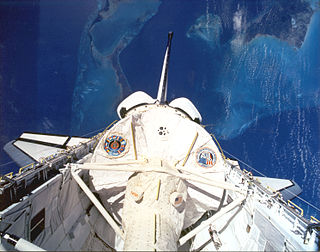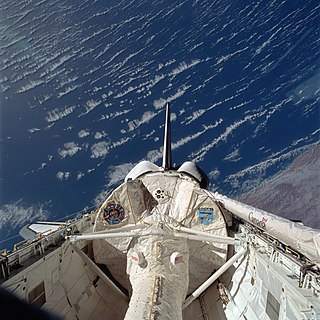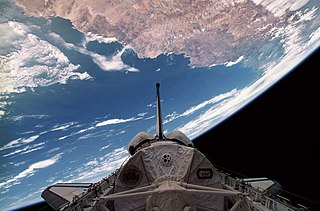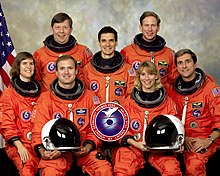
Spacelab was a reusable laboratory developed by European Space Agency (ESA) and used on certain spaceflights flown by the Space Shuttle. The laboratory comprised multiple components, including a pressurized module, an unpressurized carrier, and other related hardware housed in the Shuttle's cargo bay. The components were arranged in various configurations to meet the needs of each spaceflight.

STS-50 was a NASA Space Shuttle mission, the 12th mission of the Columbia orbiter. Columbia landed at Kennedy Space Center for the first time ever due to bad weather at Edwards Air Force Base caused by the remnants of Hurricane Darby.

STS-93 in 1999 marked the 95th launch of the Space Shuttle, the 26th launch of Columbia, and the 21st night launch of a Space Shuttle. Eileen Collins became the first female shuttle Commander on this flight. Its primary payload was the Chandra X-ray Observatory. It would also be the last mission of Columbia until March 2002. During the interim, Columbia would be out of service for upgrading, and would not fly again until STS-109. The launch was originally scheduled for 20 July but the launch was aborted at T−7 seconds. The successful launch of the flight occurred 3 days later. The payload was also the heaviest payload ever carried by the Space Shuttle system, at over 22.7 tonnes.

James Donald Halsell Jr. is a retired United States Air Force officer, a former NASA astronaut. The veteran of five Space Shuttle missions pled guilty in 2021 to two counts of manslaughter and two counts of assault as a result of a motor vehicle accident in 2016. As of May 2021, he is incarcerated in Alabama.

STS-61-A was the 22nd mission of NASA's Space Shuttle program. It was a scientific Spacelab mission, funded and directed by West Germany – hence the non-NASA designation of D-1. STS-61-A was the ninth and last successful flight of Space Shuttle Challenger before the disaster. STS-61-A holds the current record for the largest crew—eight people—aboard any single spacecraft for the entire period from launch to landing.

STS-42 was a NASA Space Shuttle Discovery mission with the Spacelab module. Liftoff was originally scheduled for 8:45 EST on January 22, 1992, but the launch was delayed due to weather constraints. Discovery successfully lifted off an hour later at 9:52:33 EST. The main goal of the mission was to study the effects of microgravity on a variety of organisms. The shuttle landed at 8:07:17 PST on January 30, 1992, on Runway 22, Edwards Air Force Base, California. STS-42 was the first of two flights in 1992 of Discovery, the second of which occurred during STS-53, which launched on December 2, 1992. The mission was also the last mission of the Space Shuttle Discovery to have a seven-member crew until STS-82, which was launched on February 11, 1997.

STS-47 was the 50th NASA Space Shuttle mission of the program, as well as the second mission of the Space Shuttle Endeavour. The mission mainly involved conducting experiments in life and material sciences inside Spacelab-J, a collaborative laboratory inside the shuttle's payload bay sponsored by NASA and the National Space Development Agency of Japan (NASDA). This mission carried Mamoru Mohri, the first Japanese astronaut aboard the shuttle, Mae Jemison, the first African-American woman to go to space, and the only married couple to fly together on the shuttle, Mark C. Lee and Jan Davis, contrary to NASA policy.

STS-65 was a Space Shuttle program mission of Columbia launched from Kennedy Space Center, Florida, 8 July 1994. The flight carried a crew of 7 and was commanded by Robert D. Cabana who would go on later to lead the Kennedy Space Center. STS-65 was an international science mission that carried the International Microgravity Laboratory (IML-2) on an 15-day mission. Columbia returned to the Kennedy Space Center on 23 July 1994.

STS-73 was a Space Shuttle program mission, during October–November 1995, on board the Space Shuttle Columbia. The mission was the second mission for the United States Microgravity Laboratory. The crew, who spent 16 days in space, were broken up into 2 teams, the red team and the blue team. The mission also included several Detailed Test Objectives or DTO's.

STS-94 was a mission of the United States Space Shuttle Columbia, launched on 1 July 1997.

STS-87 was a Space Shuttle mission launched from Launch Complex 39B of the Kennedy Space Center on 19 November 1997. It was the 88th flight of the Space Shuttle and the 24th flight of Columbia. The mission goals were to conduct experiments using the United States Microgravity Payload (USMP-4), conduct two EVAs, and deploy the SPARTAN-201 experiment. This mission marked the first time an EVA was performed from Columbia. An EVA from Columbia was originally planned for STS-5 in 1982 but was canceled due to spacesuit problems. It also marked the first EVA conducted by a Japanese astronaut, Takao Doi.

STS-105 was a mission of the Space Shuttle Discovery to the International Space Station, launched from Kennedy Space Center, Florida, 10 August 2001. This mission was Discovery's final mission until STS-114, because Discovery was grounded for a refit, and then all Shuttles were grounded in the wake of the Columbia disaster. The refit included an update of the flight deck to the glass cockpit layout, which was already installed on Atlantis and Columbia.

Roger Keith Crouch is an American scientist and astronaut who flew as a payload specialist on two NASA Space Shuttle missions in 1997.

Dirk Dries David Damiaan, Viscount Frimout is an astrophysicist for the European Space Agency. He flew aboard NASA Space Shuttle mission STS-45 as a payload specialist, making him the first Belgian in space.

Michael Landon Gernhardt is a NASA astronaut and manager of the Environmental Physiology Laboratory, and principal investigator of the Prebreathe Reduction Program (PRP) at the Lyndon B. Johnson Space Center.

Gregory Thomas Linteris is an American scientist who flew as a payload specialist on two NASA Space Shuttle missions in 1997.

Donald Alan Thomas, Ph.D. is an American engineer and a former NASA astronaut.

The Materials Science Laboratory (MSL) of the European Space Agency is a payload on board the International Space Station for materials science experiments in low gravity.

The International Space Station is a platform for scientific research that requires one or more of the unusual conditions present in low Earth orbit. The primary fields of research include human research, space medicine, life sciences, physical sciences, astronomy and meteorology. The 2005 NASA Authorization Act designated the American segment of the International Space Station as a national laboratory with the goal of increasing the use of the ISS by other federal agencies and the private sector.

The Combustion Integrated Rack (CIR) is an experiment facility installed in the International Space Station (ISS). It includes an optics bench, combustion chamber, fuel and oxidizer control, and five different cameras for performing combustion experiments in microgravity.
























